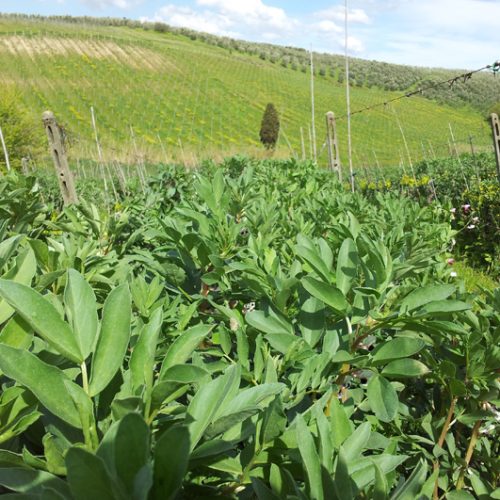Since 1967
Un’azienda biodinamica tra le colline del Montalbano
The Poggiosecco farm is located in the Montalbano area between the limestone soils and sandstone rocks of the hills of Cerreto Guidi and Vinci, a land suited to viticulture and the production of excellent wines.
The company's vineyards and olive groves extend along the border between the provinces of Florence and Siena, at about 100/350 meters above sea level, with an optimal exposure that allows for perfect ripening of the grapes and olives.
The company, operating in the area since 1967, has been certified organic since 2004 and biodynamic since 2009.
The biodynamic choice
We made this ethical choice because it seemed to us to be the only possible form of agriculture from the point of view of the historical context we are living in.
From the point of view of interventions on the soil, biodynamic agriculture aims in summary to restore the humic state of the soil with the richness of mineral and animal elements foreseen in nature; consequently the plants that grow on this soil find their natural balance by drawing from a living soil and subsoil that contains within itself the right nourishment and remedy for the maximum expression of the plant. The result is that the use of pesticides, herbicides, etc. of a chemical and synthetic nature – which have heavy side effects on the environment – is no longer necessary.
Our works
Our processes follow, in addition to seasonality, a biodynamic calendar based on specific and scientific studies on the conditions of our solar system and on the influences that the planets and their movement exert on the force of gravity and levity acting through the four elements (water, air, earth and fire) on the earth, plants and all living beings.
Through this knowledge we work by marking and dividing into four parts the processes that influence biodiversity. Our periods are divided into Radical, Leaves, Flower, Fruit with ascending and descending moon periods. The actions we perform on plants and on the earth are marked precisely by these periods; therefore the dry pre-pruning will be carried out in winter with a descending moon, while the removal with an ascending moon with incineration and reintroduction of the ashes under the row.
Even green pruning or crushing will be done in the waning moon, since with a lot of gravitational pressure the plant will have little sap in circulation and the healing of the wounds will be facilitated and less traumatic.
To complete the defense for the health of the plant, the silicon horn will be distributed nebulized in the air at the first light of dawn, after a one-hour dynamization process. No dead or chemical fertilizer is ever introduced into the soil, but green manures (legumes, grasses, composites) are sown in alternate rows, with the introduction of manure horn and biodynamic preparations dynamized for an hour and sprinkled on the soil to activate micro-fermentation processes and the development of active microorganisms that energize, vivify and therefore purify the soil.
During the season, the succession of these operations carried out in the alternation of gravity and lightness, gives a balance to our plants and to the earth, which will express with the harvest of healthy and intact fruits from an organoleptic point of view, so that they will fully express their characteristics and the terroir.
The treatments
The elements used in biodynamics have infinitesimal size similarly to what happens in homeopathy where the active principle and its dynamization are valid, that is, the act necessary to release all the energy contained in very low doses. For example, both in organic and biodynamic wines the dose of metabisulphite is 2 grams for every quintal of grapes, compared to 150 grams in conventional wines, and only for the purpose of obtaining a light disinfection of the must. Click here to edit. Our defense treatments are limited to truly infinitesimal doses of low molecule copper sulphate (S2O), lime flake and mined sulphur. For the prevention of botrytis we use clays, bentonite, ZAB. Against the grape moth, bacillus turgensis activated with cane sugar is used in biodynamics. With these very natural and system-friendly practices we avoid first of all the degeneration of the environment and therefore also of the berries that we will transform into wine.
In every ecosystem that respects itself, biodiversity is a necessary and sufficient condition to guarantee the balance and the progressive strengthening of every living manifestation in it, whether it is plants, animals or men. Recent studies (Japan) demonstrate that the evolution of one of the basic preparations used in biodynamics has had an extremely vivifying and invigorating effect in contexts of critical nuclear contamination of the territory.
The vinification
The vinifications are done biodynamically with oxygenation and cooling by light and air with pumping over and punching down.During the fermentation, delestages are carried out to slow down the vinification and lower the temperature. Once the alcoholic fermentation is finished, a few days are waited to promote the malolactic fermentation which develops aromas and perfumes, after which the racking process takes place where another 2 grams per quintal of metabisulfite are added to purify the wine, after which it is transferred to large cement vats where in winter both the decantation and the refinement and clarification processes take place.
Passed in oak barrels it spends the winter rounding out the body until returning to the vat just before summer to return again after the harvest; in the following spring it is bottled. Each movement is made in ascending moon choosing the day of flower or fruit depending on the chosen characteristic






